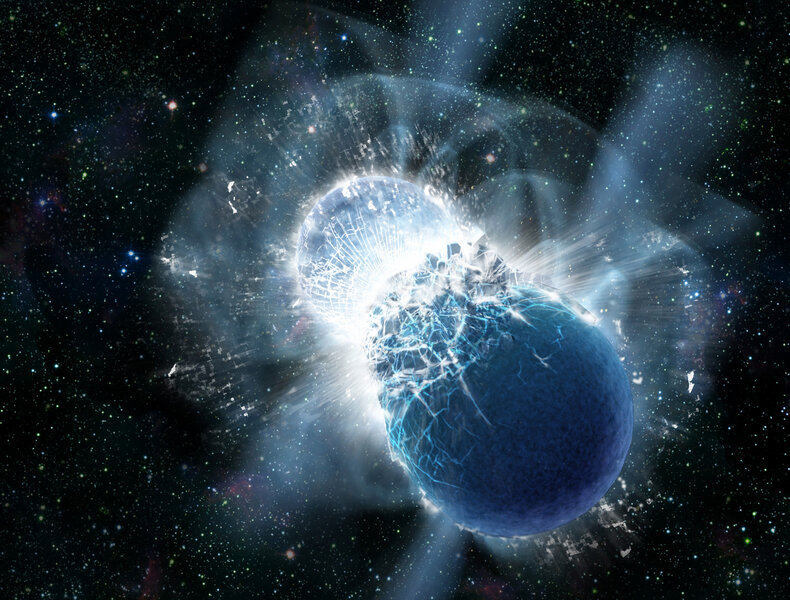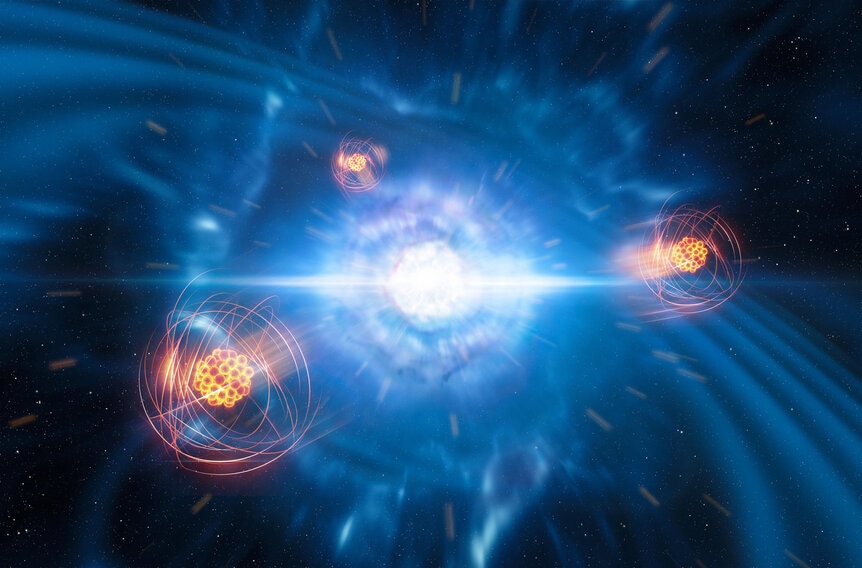Create a free profile to get unlimited access to exclusive videos, sweepstakes, and more!
Some orphan gamma-ray bursts actually live in tiny faint galaxies
Don’t you hate it when colliding neutron stars outshine their tiny dim host galaxies?

Some of the most powerful singular explosions in the Universe seem to be happening in intergalactic space, and astronomers aren’t happy about it.
Gamma-ray bursts are terrifying. They come in two general kinds: Long ones that last for more than two seconds, and short ones, called sGRBs, that last for less than two seconds. Either way, the total energy emitted is immense. For that short time they can be trillions of times more luminous than the Sun.
Long GRBs are caused when a massive star’s core collapses and forms a black hole, sending out two powerful beams of energy that tear through the star. Short ones are caused when either a pair of binary superdense neutron stars collide and merge or a single neutron star is destroyed by a black hole. Either way a black hole (or a powerful magnetar) is left behind, and the merger causes an intense and powerful explosion. We call the visible light flash a kilonova, because it has roughly a thousand times the energy of a classic nova, though still less than a typical supernova. Much of the rest of the energy is blasted out in high-energy gamma rays. They’re so bright we can see them in galaxies billions of light years away, a decent fraction across the visible Universe.
We’ve been observing these ridiculously big bangs since the 1960s, but it wasn’t until the 1990s that we really started understanding them; they flash into existence and fade so rapidly it wasn’t until then that we had the technology to track down their locations on the sky. This is actually a really cool story and I urge you to find out more.
Over the decades enough were seen, especially after the launch of the Neil Gehrels Swift GRB-detecting satellite in 2004, that trends were able to be seen, and one became troubling: While many were able to have their host galaxy seen once the bright flash subsided, a lot of sGRBs appeared to be hostless. Even after they faded, deep observations didn’t show any obvious host galaxy.
There are two possible explanations for this. One is that the galaxy is just too faint to see; tiny ones called dwarf galaxies can be much smaller than the Milky Way, and invisible to our telescopes from great distances. Another idea is that they got kicked out of their host. Neutron stars form when massive stars explode, and you need two massive stars in orbit around each other to form a binary neutron star system. If one or both of the supernova explosions is off-center it can give a hellacious kick to the system, acting like a rocket exhaust, flinging the neutron star binary away at speeds up to a million kilometers an hour. Over millions or billions of years they can shoot right out of a galaxy, especially a small one.
So which is it? To find out a team of astronomers looked at over a hundred known sGRBs to see if they could solve this mystery [link to paper]. They wanted to find ones that didn’t appear to have a host galaxy and that were well located on the sky to high accuracy. They narrowed the field down to 31 candidates, and observed them with the 4.3-meter Lowell Discovery Telescope to see if they could find a host galaxy in that position. If they did, they took spectra to get the galaxy distance. If not, they turned to even bigger or better ‘scopes — Keck, Gemini, Gran Telescopio Canarias, VLT, even Hubble — to go much deeper. Again, if they found a host galaxy they used photometric redshifts to get their distance.
In the end, they found that out of the 31 sGRBs, 18 had very faint galaxies underlying them, ranging from 1.3 to 10 billion light-years from us. Thirteen of them, though, did not have obvious hosts. They call these ones “observationally hostless” for two reasons. One is that maybe there is still a galaxy there but it’s too faint to see. The other is that when you go deep you’ll find lots of faint fuzzies around the sGRB position, and you can’t tell which one might have been the host. If the neutron star binary did get shot out, it could be any of them.
A majority of these sGRBs occurred offset from the galaxy center, with a median value of about 20,000 light-years. Seventy percent of them occur within about 35,000 light-years of their host’s core. Long GRBs tend to be much closer to their host centers than this. It’s possible that the neutron star binary progenitors of some formed in globular clusters, which tend to be far from the galaxy’s center, or in their galaxy’s halo.
Irritatingly, the mystery remains. Some sGRBs still don’t appear to have hosts, and it’s not clear why. The idea that they were shot out seems favorable, but there’s a problem with that: The flash we see is due in part to material ejected at a decent fraction of lightspeed slamming into material surrounding the stars. But there’s not enough material between galaxies to do this! So maybe these orphaned sGRBs really do have super faint hosts and we can’t see them. But there’s no way at this time to know.
These observations did help find some fainter hosts, so that’s good. And they found some trends that could help us understand these explosions; for example 80% of these bursts happen less than 8 billion light-years from Earth, and more distant sGRBs tend to be farther out from their host galaxy core relative to galaxy size than nearby ones. It’s not clear why that latter one might be. More mysteries.
Colliding neutron stars create lots of interesting elements like strontium, platinum and gold, and we’d like to know how these are created in the Universe. Plus we see gravitational waves from these events, so it would be nice to know how they form, how often, how far from Earth, and where they are in their host galaxy.
Assuming they have one. Perhaps with bigger ‘scopes and more observations, eventually we’ll figure this out.





























